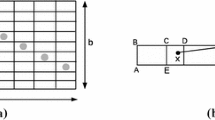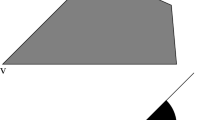Abstract
The unit ball random geometric graph \(G=G^d_p(\lambda,n)\) has as its vertices n points distributed independently and uniformly in the unit ball in \({\Bbb R}^d\), with two vertices adjacent if and only if their ℓp-distance is at most λ. Like its cousin the Erdos-Renyi random graph, G has a connectivity threshold: an asymptotic value for λ in terms of n, above which G is connected and below which G is disconnected. In the connected zone we determine upper and lower bounds for the graph diameter of G. Specifically, almost always, \({\rm diam}_p({\bf B})(1-o(1))/\lambda\leq {\rm diam}(G) \leq {\rm diam}_p({\bf B})(1+O((\ln \ln n/{\rm ln}\,n)^{1/d}))/\lambda\), where \({\rm diam}_p({\bf B})\) is the ℓp-diameter of the unit ball B. We employ a combination of methods from probabilistic combinatorics and stochastic geometry.
Similar content being viewed by others
Author information
Authors and Affiliations
Corresponding authors
Rights and permissions
About this article
Cite this article
Ellis, R., Martin, J. & Yan, C. Random Geometric Graph Diameter in the Unit Ball. Algorithmica 47, 421–438 (2007). https://doi.org/10.1007/s00453-006-0172-y
Received:
Published:
Issue Date:
DOI: https://doi.org/10.1007/s00453-006-0172-y




